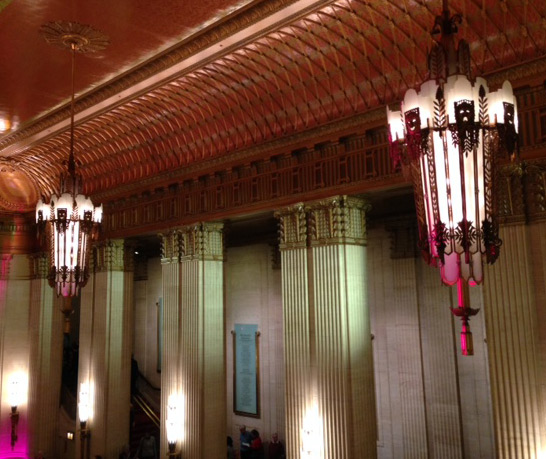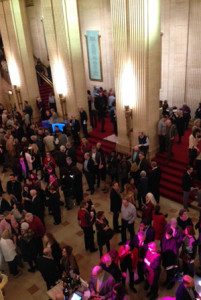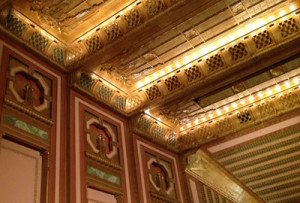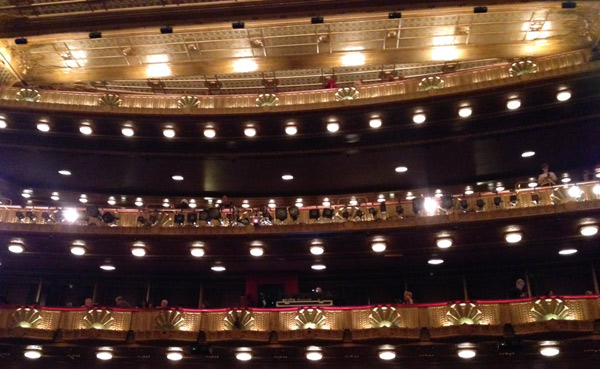I’ve recently seen my first–and second–operas, and I have tickets for two more. I don’t know yet if I’m really an opera fan.
Hmmmm.

Chandeliers: Lyric Opera House main lobby
How and why did I end up with tickets to four operas without knowing if I like opera? Well, there’s a love story involved–a love affair with a book. But there’s a lot more, too, because the book only explains one of the four tickets. This is a tale of marketing. Good marketing. Marketing that can teach us something.
Lyric’s finances: Setting the stage
First, some background: The Lyric Opera of Chicago used to boast ticket sales higher than 100%. (How is that even possible? Performances would sell out, and ticket holders who couldn’t attend would turn their tickets back into the box office to resell.) An enviable position, but nothing lasts forever. While the opera continues to operate in the black, ticket sales fell 11 percent from 2014 to 2015. Even before that, in June 2014, Lyric General Director Anthony Freud was quoted saying: “In common with opera companies around the country, we see ultimately a declining trend in earned revenue, and, therefore, an increasing dependence on contributed revenue.”
So how does an opera company increase ticket sales? From an audience perspective, either you bring current ticket holders in more often, or you attract new audience members. I’m the new audience member. So how did I come to hold tickets for four performances? Chalk that up to creative programming and marketing.
Bel Canto: The opening act

Intermission
I’m a long-time but casual fan of classical music. Until this year, I had never seen any opera, but had long wanted to do so. I number quite a few opera aficionados among my friends, but also a few people who have seen opera and don’t really care for it. My husband used to work in the back office at the Lyric and enjoys the spectacle of the performance, but isn’t a hard-core fan. I didn’t know if I would like it, but my failure ever to go seemed a missed opportunity, a gap in my experience. I should give this a try, I thought; what if I’m missing out on a transformative experience?
So call me predisposed to buy my first opera ticket. That makes me a perfect target for Lyric Opera’s marketing. Still, I went years without attending. Then, sometime last year, a friend told me that the Lyric had commissioned a new opera from one of my favorite books: Ann Patchett’s Bel Canto. I have a long-term love affair with this book, dating to shortly after it was published in 2001. If ever I were going to see an opera, this was the one. I knew that I wanted tickets for this opera.
And yet I didn’t buy them right away. I looked at dates, considered recruiting a large group to take advantage of a group discount, put some feelers out on Facebook but got little response. I knew I would go, but I still didn’t buy the tickets.
Enter marketing, stage left
In late October, I learned that the Lyric was staging a series of free community events in connection with this world premiere: a chamber music concert curated by the opera’s composer; a discussion featuring Ann Patchett and Renée Fleming, creative consultant for the new opera; and a group discussion featuring all of the principals involved in the opera’s creation. I immediately snagged tickets for the first two events. I still didn’t have opera tickets, although I knew I would get them eventually.
What just happened? On the surface, it looks like I got tickets to two free events, rather than paying for opera tickets. And those free events are almost certainly going to cost the Lyric money to stage. Net loss for the Lyric? Actually, no – because below the surface, what happened is that the Lyric cast a fly into the water, I nibbled, and now I’m hooked. (Apologies for mixing my metaphors.)

Inside the Ardis Krainik Theatre
Let’s assume that I was going to buy tickets for Bel Canto the opera regardless whether the Lyric staged any other events in connection with it. (Certainly that was my plan, although there is a fairly strong possibility that I would have forgotten about the upcoming premiere without the community events to create additional publicity. I had no relationship yet with the Lyric, and they had no way to market to me.) But even so, I still would be going to only one show. How did I end up with tickets to three others?
- The free events built my interest and kept me thinking about Bel Canto. They also kept me talking about this world-premiere opera, both in conversations with friends and on social media, and on this blog.
- The free events introduced me to Renée Fleming, the world-renowned soprano who serves as Lyric’s first-ever creative consultant, who struck me as canny, smart, and surprisingly self-deprecating for a diva. She made me want to see her perform–and she happened to be singing the lead role in The Merry Widow at the Lyric just before the premiere of Bel Canto. (Coincidence? Not likely.)
- Attendance at the free events showed there was enormous interest in the Bel Canto project. In some cases the events were filled to capacity and people without tickets lined up at the door, hoping for no-shows to make space for them to get in.
- By reserving tickets to the free events, I gave my email address to the Lyric. That gave the Lyric’s marketing team a direct channel to reach me.
- The Lyric offered discounts on Bel Canto tickets to attendees at its free events. This both made the purchase more affordable and created some sense of urgency, introducing the possibility that other attendees might take advantage of the offer and start to create some ticket scarcity.
- Once I had bought my Bel Canto tickets, the Lyric followed up with additional discount offers to convert me into a subscriber. And not small discounts, either: I took advantage of a week-long Cyber Monday promotion to get main-floor tickets to three other shows for $33 each. That’s what it took to get me to buy tickets to four operas before ever seeing a single one.
Even after I had purchased tickets to additional performances, the Lyric offered me more ways to deepen my experience with Bel Canto. Just a couple of days before the opera debuted, I learned that the world premiere would be broadcast live on radio. I checked it out and found out that all of the Lyric Opera opening nights are simulcast on radio. You can bet I’ll be listening in when future shows debut; I think it will deepen my appreciation of the shows I’m attending, and it’s quite possible that I’ll end up attending additional performances as a result.
I also found a treasure trove of Lyric videos on YouTube, including stars rehearsing their arias. Here’s soprano Danielle de Niese singing her opening aria from Bel Canto:
I also checked out the Lyric Opera’s Facebook page and Twitter feed, and found that the Lyric uses social media both to publicize ticket discounts and to share sneak previews of costumes and sets. For example:
Art gives us a lens through which to understand our violent world. Proud to contribute to this vital work. #belcanto pic.twitter.com/YBkAFjFw9q
— Lyric Opera Chicago (@LyricOpera) December 2, 2015
Learning from the Lyric
The Lyric Opera did so many things right; I can hardly count them all. First, they chose an enormously popular and critically acclaimed book to commission as a new opera. I was not the only person attending the Patchett-Fleming discussion for the opportunity to see Patchett and hear her discuss this book. The community events generated publicity for and excitement about the new opera while also providing an entry point to introduce the Lyric to potential new audience members such as myself. And the Lyric’s targeted marketing, both to attendees of the community events and to single-ticket holders, provided me the incentives I needed to buy tickets both for The Merry Widow and for two other shows that I hadn’t even been thinking about.
We can’t all afford to commission an award-winning book or author to boost interest in our events, activities or products. But we can learn from the Lyric’s success and adapt some of their strategies to our own situations.
- If there’s an audience you’re not currently reaching, what might be an entry point to get them interested in your work? For the Lyric Opera of Chicago, it was the book Bel Canto. For your audience, it might be visual art or popular music. If you work in a medical field, it might be cross-over between your specialty and another area of medicine. If you do issues-based work, it could be a political or news-related event. Consider your audience’s other interests, and how they can help you make deeper connections.
- How can you generate publicity for your work? What can you offer to your community for free to engage them in your activities and make them want to learn more about you?
- Is there an ambassador you can identify and recruit to attract a new audience or deepen your engagement with your existing patrons? Renée Fleming is a charismatic personality, and Lyric does well to get her out into the community talking with people who have never seen her perform. Ann Patchett brought her own audience to the Lyric’s free events and was a powerful spokeswoman to convince them they should see the opera. When Patchett says the libretto written for the opera “should be the Cliff’s Notes” to the book, that’s a powerful endorsement to anyone who loves her book.
- Does your current marketing treat everyone the same way or target specific offers to different people, based on the next step you would like them to take? Do you send the same emails and offer the same promotions to everyone? Or do you segment your target audiences and offer different promotions that address their specific concerns and needs? The Cyber Monday discount that shifted me from a one-time buyer to a four-ticket subscriber wasn’t advertised on the Lyric Opera website. It was sent to me via email as a non-subscriber; I know at least one Lyric subscriber who didn’t get the same offer.
- Can you develop media partnerships to help publicize your work, broaden your reach, or deepen your connection with supporters/patrons/customers?
Most organizations aren’t as big as the Lyric, and we don’t all have the Lyric’s resources and connections. But we have opportunities and resources of our own. The Lyric’s example suggests ways to reach out and broaden an organization’s appeal, both to connect with new audiences and to deepen existing relationships.

Balcony, Ardis Krainik Theatre, Lyric Opera House, Chicago
